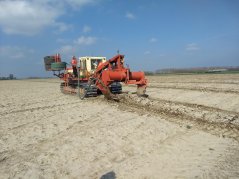
Online
MOOC Drainage in Agriculture: controlling water and salt levels in the soil
Get prepared for heavier rainfall and the increasing demand for food! The #1 agricultural university of the world will teach you how to design and implement effective drainage systems in agriculture. You will learn how to create a perfect soil profile for optimal growing conditions for crops and help feed the growing world population. Enroll now and prepare for the effects of climate change by draining excess water.
Why follow this course?
Increasing scarcity of natural resources
The demand for safe and healthy food is rapidly increasing. The world population is growing and is projected to reach 9.8 billion in 2050. How do we prepare for this and how are we going to be able to feed all these people?
Global climate change raises the pressure on supply and demand for water. Changing temperatures and long-term variation in annual precipitation amounts and regional distribution patterns require more ways to control water levels. In addition to the changing climate, cropping patterns are diversifying and field irrigation methods are changing.
Relevance of drainage

It is clear that the food production mainly has to come from improvements in agricultural water management on existing agricultural lands. In light of all these changes in water demand, supply and use, the role of (subsurface) drainage has changed from a single-purpose measure for controlling waterlogging and/or salinity to an essential element of integrated water management under multiple land use scenarios.
Learn how drainage can contribute to sustainable food security
Join this course to advance your knowledge in drainage, drainage systems and solutions, and to help securing a sustainable food supply. In this course, you will work on different modules, apply the knowledge gained directly to your home country drainage situation. Furthermore, you will learn from other cases and learners worldwide, expanding your horizon on the global importance of drainage.

Depending on your background and interest, you may decide by yourself in which sequence you do these three modules. But you should realize that in Module 5, all these different aspects of drainage are integrated to discuss the changing role of drainage in agricultural water management.
Is this course for you?
This course was developed for professionals and students from various backgrounds, especially those who are interested in agricultural water management and want to broaden their understanding of drainage planning, design, and management, and drainage-related research and training. Although specifically watermanagers and waterengineers, agricultural engineers, irrigation professionals, hydrologists, and agricultural policy makers join this course, the course is open and accessible to everyone.
Do not miss out on the opportunity to join this online course and upgrade your knowledge on drainage for agricultural lands.
What you will learn
- Understand the concept of drainage and its role in agricultural water management
- Explain physical and agro-hydrological principles underlying drainage of agricultural land
- Make water and salt balances to calculate drainage needs
- Formulate drainage criteria
- Make sound estimates for drainage parameters needed to design drainage systems
- Understand differences between steady-state and unsteady-state drainage approaches
- Understand the need for more control in agricultural drainage management
- Design drainage system that enable more operational control
Programme & topics
The course consists of five modules.
In Module 1, the need for drainage, the drainage methods and the design approaches for agricultural drainage systems are introduced. In Module 2 you will learn more about the hydrological principles related to drainage and drainage design equations. Module 3 discusses the general aspects of drainage of saline and sodic soils and Module 4 is an introduction to the implementation and operation & maintenance of drainage systems.